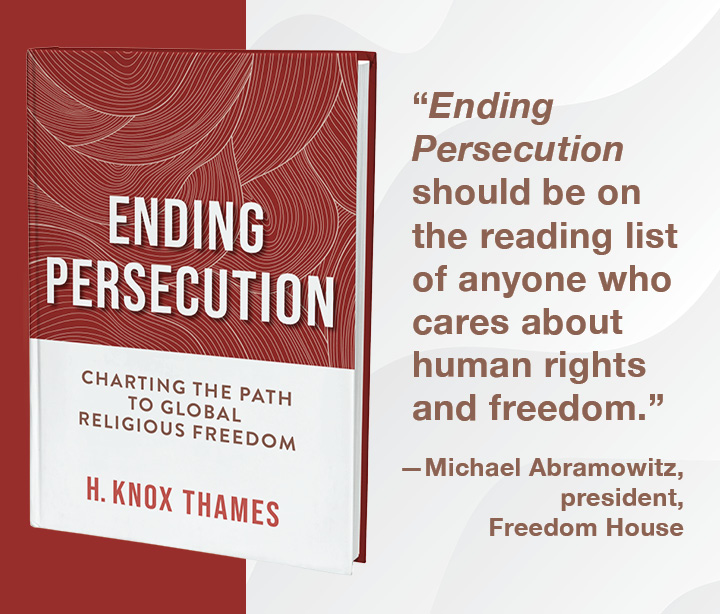
Excerpt| Book Excerpts, International Relations and Foreign Policy, Political Science and Theory, Religion and Theology
Today, a scourge of religious persecution is impacting every faith community around the globe. In Ending Persecution: Charting the Path to Global Religious Freedom, author H. Knox Thames takes readers to some of the world’s most repressive countries in the Middle East and Asia, exposing the harsh reality of religious repression. To help the persecuted in the twenty-first century, Thames argues, the United States must revitalize its approach and recommit to ending oppression by supporting coalition building and interfaith tolerance.
Religious terrorist organizations are one of the most vexing problems for policymakers. And they are a clear and present danger for vulnerable communities, as terrorists violently target groups deemed defective or dissenting to their warped ideology. Terrorists use brutal tactics to instill fear and project power. Unfortunately, religious minorities are often the first victims who fall prey to their cruelty. And when terrorists claim an Islamic identity, members of Muslim communities denouncing their abhorrent ways are also targeted for murder.
Immense challenges follow a terrorist strike, as their barbaric acts of persecution shatter a community’s sense of safety. Their expansionist goals have no room for human rights, religious freedom, or pluralism. Their violence is unlimited. ISIS, Al Qaeda, Boko Haram, and others all lay claim to Islamic teachings, despite consistent pushback from Muslims worldwide that the faith does not condone violence to advance political or spiritual goals. And when groups like these wrap themselves in the flag of piety, terrorists can justify their heinous acts as divinely directed while trying to ingratiate or co-opt a faith community’s beliefs.
Terrorist organizations seek to exacerbate societal cleavages or prejudices to advance their agenda, using lawful and dark networks to achieve their objectives. The wider world views them as criminals, but they position themselves as faith-based organizations. Networked through religion and criminality, such dark faith-based organizations often find space to operate in failed or failing states. As a result, governments have struggled to defeat both the violence and the ideology of terrorist groups.
As Chapter Ten will highlight, after a suicide bombing or other attack, there are few good or easy answers to mitigate the impact of terrorist persecution targeting religious minorities and victimized communities. As we will see, when dealing with genocide-level attacks in Iraq, the State Department spent much time debating how to label mass atrocities. While accurate descriptions can bring solace to communities, it does not automatically open new resources. After attacks against specific groups, responses mostly focus on picking up the pieces, helping communities rebuild, and providing security. Much was tried in Iraq, but other situations were ignored.
Smarter Engagement
Religiously inspired terrorism employs theological arguments instead of political manifestos to justify deadly acts. Consequently, policymakers need to understand the role of religion and defend space for pluralism when fighting religiously inspired terrorism. Scholars and academics have studied the interconnectedness of terrorism and religion for years. For example, the Global Terrorism Index found, “Among developing nations, terrorism is associated with religious or ethnic ruptures and corruption.” Religiously motivated terrorism is not just a problem in the developing world. The Index also reported how “religiously motivated terrorism has been the deadliest form of terrorism in the West over the past two decades.” Historian Scott Appleby has argued for developing a deeper understanding of religious fanaticism, and integrating it into our analysis of tribal, regional, and international conflict. His book Ambivalence of the Sacred explained the shared motivations of both religious terrorists and religious peacemakers, highlighting the importance of understanding what causes each to take vastly different paths in fighting injustice (real or perceived).
Terrorists are beyond the reach of traditional diplomatic engagements, so American diplomats and service members need to understand the religious landscape better. While a kinetic response is often required, a terrorist group’s ideology can live beyond the demise of individual terrorists. As the conflicts in Afghanistan and Iraq increasingly took on a religious complexion, policymakers took efforts to better understand and engage the religious landscape and key leaders.
The top U.S. military leaders recognized religious narratives were partly fueling the wars of Afghanistan and Iraq, and they realized chaplains intrinsically get religion. Some chaplains had successfully built bridges with Muslim religious leaders through personal initiative, which helped bring moderates alongside U.S. government efforts to defeat terrorists. To make that approach doctrine, the Pentagon issued in 2013 Joint Publication 1-05 to help commanders in their Areas of Operation see the religious landscape. Focused on religious affairs in joint operations, it allows chaplains to serve “as principal advisor to the joint force commander (JFC) on religious affairs and as key advisor on the impact of religion on military operations.” Unlike diplomats, chaplains could liaise with religious communities in explicitly faith-centric ways and provide commanders with a better feel of the strategic environment. JP 1-05 told commanders they could deploy chaplains in such a way while not violating their non-combatant status.
Also in 2013, the State Department released the “U.S. Strategy on Religious Leader and Faith Community Engagement” and launched the Office of Religion and Global Affairs. The strategy focused engagement on three key policy objectives and encouraged “U.S. government officials to develop and deepen their relationships with religious leaders and faith communities as they carry out their foreign policy responsibilities.” Shaarik Zafar took the initiative to draft the strategy while on detail to the National Security Council from the Department of Homeland Security. The strategy recognized “religious leaders and faith communities are making significant contributions to sustainable development, the promotion and protection of human rights, and conflict mitigation and resolution,” and enumerated ways to partner with religious communities on these three priorities.
(excerpted from chapter 10)